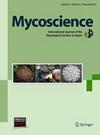近年来航空水生真菌的研究,特别关注分生孢子形态的多样性和趋同进化
IF 1.4
4区 生物学
Q4 MYCOLOGY
引用次数: 0
摘要
航空水生真菌是栖息在停滞淡水环境中淹没的腐烂底物中的腐生植物生态类群。它们产生三维形状的多细胞分生孢子,通过在分生孢子细胞之间保持空气漂浮在水面上。由于分生孢子形态多样,因此根据分生孢子的特征进行属和种水平的分类。它们大多被称为子囊菌或担子菌的无性形态。近年来的系统发育研究表明,空气水栖真菌主要出现在利多菌、多菌和索达菌中。此外,系统发育树还显示,空气水真菌具有多系起源,在淡水环境的选择压力下,不同谱系真菌在趋同进化过程中产生了相似的三维分生孢子形态。最近的研究表明,气水真菌的祖先是陆生真菌。本文章由计算机程序翻译,如有差异,请以英文原文为准。
Recent studies on aero-aquatic fungi, with special reference to diversity of conidial morphology and convergent evolution
Aero-aquatic fungi compose an ecological group of saprophytes inhabiting the submerged decaying substrates in stagnant freshwater environment. They produce three-dimensional shaped, multi-cellular conidia, which float on water surface by holding air between conidial cells. Because the conidia show diverse morphology, genus and species level classification have been based on their features. They are mostly known as asexual morphs of Ascomycota or Basidiomycota. Recent phylogenetic study revealed the aero-aquatic fungi appeared mainly in the lineages of Leotiomycetes, Dothideomycetes, and Sordariomycetes. Furthermore, the phylogenetic tree showed the aero-aquatic fungi have polyphyletic origins and similar three-dimensional conidial morphology generated as a convergent evolution among different lineages of fungi by the selection pressure for inhabiting freshwater environment. Recent studies suggested the ancestors of the aero-aquatic fungi were terrestrial fungi.
求助全文
通过发布文献求助,成功后即可免费获取论文全文。
去求助
来源期刊

Mycoscience
MYCOLOGY-
CiteScore
3.00
自引率
7.10%
发文量
32
审稿时长
3 months
期刊介绍:
Mycoscience is the official English-language journal of the Mycological Society of Japan and is issued bimonthly. Mycoscience publishes original research articles and reviews on various topics related to fungi including yeasts and other organisms that have traditionally been studied by mycologists. The research areas covered by Mycoscience extend from such purely scientific fields as systematics, evolution, phylogeny, morphology, ecology, physiology, biochemistry, genetics, and molecular biology, to agricultural, medical, and industrial applications. New and improved applications of well-established mycological techniques and methods are also covered.
 求助内容:
求助内容: 应助结果提醒方式:
应助结果提醒方式:


